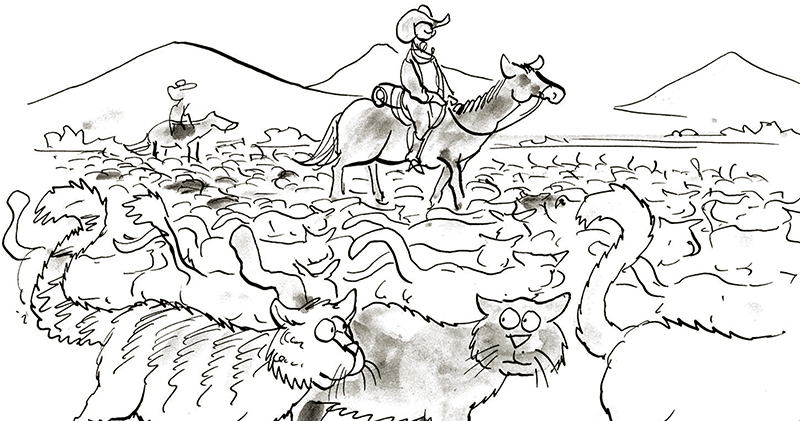The Art of Herding Cats
By Jeff Finkelstein
In this article rather than get into some more of my rules, I am covering one of the most difficult things we as leaders, whether of people or technology, need to do. I’m not talking about creating technologies, managing projects, finding funding, or other activities. I am talking about one of the most difficult things we have to do. I call it “cat herding,” which is something we all struggle with for many reasons. Most of which are not the cats’ fault, instead it is our expectation of cats acting like dogs, and subsequent disappointment when they do not act as we desire.
One of my tasks at SCTE has been to set up and guide our senior executives through a series of meetings with vendors and operators to allow for private discussions and see demos that one cannot usually see in larger settings. It takes months of coordinating arrival and departure times, figuring out who to meet with based on current guidance, making sure there is plenty of time to get between meetings while allowing for beverages and bathrooms, keeping everyone together so no time is spent looking for stragglers, and making sure everyone has fun while walking about three miles from start to finish. There is much to organize as you would expect, but one of the most difficult tasks is not setting up the meetings, but dealing with those trying to get onto the agenda by skipping the process even though they were fully aware of it. Given the level of those in the meetings it needs to be handled with a gentle, but firm touch.
I was once called a “Professional Cat Herder” by our CTO at the time, Chris Bowick, for managing to organize something I called the DOCSIS Summit. The summit was a chance for many of our field and corporate engineers to come together and spend three days in meetings with vendors getting into the details of how things actually worked and finding better ways to handle the full lifecycle of DOCSIS gear, passives, and actives. There may have been evenings full of frivolity, but I don’t think much evidence exists that can come back to haunt us. At least, I hope not…
I thought about that moniker and over time realized it is a skill many lack. As I learned organizing the events the “cats” did not behave as I wanted. Things may have started as an organized event, but as the cats got excited about things they would wander here and there, to and fro, willy and nilly, in general just do what they bloody well wanted. While I initially would get frustrated by this, I learned that there were ways that worked and did not work getting them from point A to B with the minimal energy. It was a long painful learning process, but eventually it got through my thick skull.
Here are my observations and learnings from those times. I hope you find them of interest and valuable.
Cats don’t like to be herded
One of the most difficult things to realize is that cats do not like being herded. They don’t like being told to go here or there, at least without a good reason. Cats can be obstinate critters who will let you pet them for a few moments, then in a flash will turn around and gently bite your hand. Not to hurt you, but to let you know they are in charge. They need to feel that they are making the decision to follow along.
Cats prefer to herd themselves
Cats are not herd animals like dogs, sheep, horses, etc. They will go their own way if left alone. Like all of us, they have their own ideas, agendas, and goals. This is one reason why when we have big projects that cover many technology areas, we need someone managing things that can show the cats why following other cats is of critical importance.
Cats understand that they sometimes need to be herded
This is an interesting challenge about cats. While they do not want to be herded, they realize they need to be herded. Things may start out with them moving in the desired direction, but a simple puff of wind that causes a leaf to move will allow them to get distracted. It is essential to keep the roadmap in their view to help avoid those moments when things stall. They will still wander off on their own, but that is where a gentle word or touch may be enough to get things back on track. This is of greatest importance when there are cats that do not get along as it requires skill to navigate the journey.
Cats don’t like being reminded that they are being herded
It is a natural response to get frustrated when cats wander off. After all, they asked us to put together a path for them to follow. Once we are on the path those shiny objects look so tantalizing that they have to be investigated. As other cats join in or find other shiny things to look at, it makes it exponentially harder to keep others on track. It is easiest to find ways to keep things moving in the proper direction rather than keep herding the errant cats back to the group.
Harsh herding has negative consequences
Cats respond to positive reinforcement. A single negative experience will stay with them a long, long time. It takes significant effort on your part to help them through that. While they know they need to be herded, the process of herding them cannot be done with a heavy hand as that just increases the likelihood for more straying from the path.

Herd gently, but firmly, with affection or fish as a reward
All cats are different. While a few may respond to a firmer hand, what they really want is to be rewarded for their following along. Some like the space between their ears scratched, a belly rub, a foot massage, or a nice piece of fish. Kind words and sharing of pertinent information is often enough. Though a nice piece of herring is always appreciated.
Remember we are all cats and need herding at one time or another
It is easy to think that as a herder of cats you are above them. The reality is we are all cats and being herded by someone on occasion. Think about what it takes to get you following the path. Do you respond better to kindness? Does a kitty treat do the trick? A belly rub? We are all different in how we respond to those showing us the direction, but we all want to know why we need to do certain things, see specific technologies, or talk to particular people.
Sharing of information is critical to success. When cats understand why they are doing something they do a better job and are more willing to follow along.
Always remember that as transformative leaders we share a transcendent purpose pointing the way to a new reality. However, cats live in the here and now, and do not always think about tomorrow or the future.
I hope you enjoyed this article and find my flights of fancy of value. It would be great to hear from you with words of encouragement, corrections, ideas for future articles, whatever you feel like sharing. Also, a nice piece of herring goes a long way. Cheers!
 Jeff Finkelstein
Jeff Finkelstein
Chief Access Scientist,
Cox Communications
Jeff.Finkelstein@cox.com
Jeff Finkelstein is the Chief Access Scientist for Cox Communications in Atlanta, Georgia. He has been a key contributor to engineering at Cox since 2002 and is an innovator of advanced technologies including proactive network maintenance, active queue management, flexible MAC architecture, DOCSIS 3.1, and DOCSIS 4.0. His current responsibilities include defining the future cable network vision and teaching innovation at Cox. Jeff has over 50 patents issued or pending. He is also a long-time member of the SCTE Chattahoochee Chapter and member of the Cable TV Pioneers class of 2022.
Shutterstock




